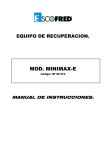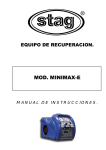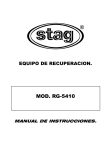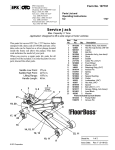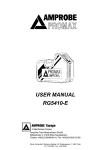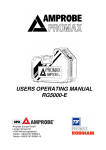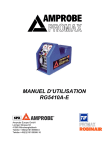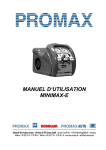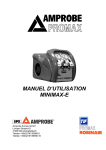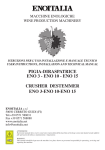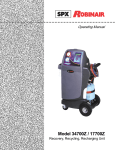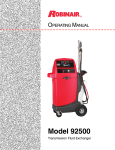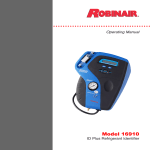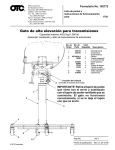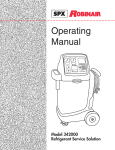Download Operating Manual
Transcript
TM REFRIGERANT RECOVERY MACHINE USER’S MANUAL MINIMAX SPX Corporation • Owatonna, MN Toll Free: (800) 327-5060 • Fax: (866) 287-7222 www.PromaxRecovery.com Explanation of Safety Signal Words DANGER : Indicates an imminently hazardous situation which, if not avoided, will result in death or serious injury. WARNING : Indicates a potentially hazardous situation which, if not avoided, could result in death or serious injury. CAUTION : Indicates a potentially hazardous situation which, if not avoided, may result in minor or moderate injury. CAUTION : Used without the safety alert symbol indicates a potentially hazardous situation which, if not avoided, may result in property damage. TABLE OF CONTENTS Safety Precautions . . . . . . . . . . . . . . . . . . . . . . . . . . . . . . . . . . . . . . . . . . . . . . . .4 Understanding Refrigerant Recovery . . . . . . . . . . . . . . . . . . . . . . . . . . . . . . . . . . .5 Recovery Tank Information . . . . . . . . . . . . . . . . . . . . . . . . . . . . . . . . . . . . . . . . . .6 Purging Non-condensable Gases . . . . . . . . . . . . . . . . . . . . . . . . . . . . . . . . . . . . .7 Maintenance . . . . . . . . . . . . . . . . . . . . . . . . . . . . . . . . . . . . . . . . . . . . . . . . . . . . .8 Operating Instructions . . . . . . . . . . . . . . . . . . . . . . . . . . . . . . . . . . . . . . . . . . . . . .9 Minimax Self-Purge . . . . . . . . . . . . . . . . . . . . . . . . . . . . . . . . . . . . . . . . . . . . . . .10 Push/Pull Method Instructions . . . . . . . . . . . . . . . . . . . . . . . . . . . . . . . . . . . . . . .11 Tank Pre- or Sub-cooling Instructions . . . . . . . . . . . . . . . . . . . . . . . . . . . . . . . . .12 Recovery / Tank Pre- or Sub-Cooling for Fixed Hose Set-up . . . . . . . . . . . . . . . .12 Refrigerant Recycling . . . . . . . . . . . . . . . . . . . . . . . . . . . . . . . . . . . . . . . . . . . . .13 Parts List . . . . . . . . . . . . . . . . . . . . . . . . . . . . . . . . . . . . . . . . . . . . . . . . . . . . . .14 Replacement Kits and Accessories . . . . . . . . . . . . . . . . . . . . . . . . . . . . . . . . . . .14 Minimax Wiring Diagram . . . . . . . . . . . . . . . . . . . . . . . . . . . . . . . . . . . . . . . . . . .15 Minimax-KT Wiring Diagram . . . . . . . . . . . . . . . . . . . . . . . . . . . . . . . . . . . . . . . .15 Installation of Optional 80% Tank Capacity Sensing Components (Kit KT-5001) . .16 Troubleshooting . . . . . . . . . . . . . . . . . . . . . . . . . . . . . . . . . . . . . . . . . . . . . . . . .17 One-Year Warranty . . . . . . . . . . . . . . . . . . . . . . . . . . . . . . . . . . . . . . . . . . . . . . .18 EPA Certification Form . . . . . . . . . . . . . . . . . . . . . . . . . . . . . . . . . . . . . . . . . . . .19 Environmental Protection Agency (EPA) Instructions . . . . . . . . . . . . . . . . . . . . . .20 EPA Regional Offices . . . . . . . . . . . . . . . . . . . . . . . . . . . . . . . . . . . . . . . . . . . . .20 3 SAFETY PRECAUTIONS WARNING: To prevent personal injury, ALLOW ONLY QUALIFIED PERSONNEL TO OPERATE THE UNIT. Before operating the unit, read and follow the instructions and warnings in this manual. The operator must be familiar with air conditioning and refrigeration systems, refrigerants, and the dangers of pressurized components. If the operator cannot read this manual, operating instructions and safety precautions must be read and discussed in the operator’s native language. – Si el operador no puede leer las instrucciones, las instrucciones de operación y las precauciones de seguridad deberán leerse y comentarse en el idioma nativo del operador. – Si l’utilisateur ne peut lire les instructions, les instructions et les consignes de sécurité doivent lui être expliquées dans sa langue maternelle. PRESSURIZED TANK CONTAINS LIQUID REFRIGERANT. Do not overfill the internal storage vessel, because overfilling may cause explosion and personal injury or death. Do not recover refrigerants into nonrefillable containers; use only federally authorized refillable containers (DOT spec. 4BW or 4BA). HOSES MAY CONTAIN LIQUID REFRIGERANT UNDER PRESSURE. Contact with refrigerant may cause personal injury. Wear protective equipment, including safety goggles. Disconnect hoses using extreme caution. DO NOT BREATHE REFRIGERANT AND LUBRICANT VAPOR OR MIST. Exposure may cause personal injury, especially to the eyes, nose, throat, and lungs. Use the unit in locations with mechanical ventilation that provides at least four air changes per hour. If accidental system discharge occurs, ventilate the work area before resuming service. TO REDUCE THE RISK OF FIRE, use the shortest possible extension cord with a minimum size of 14 AWG. An extension cord may overheat and cause fire. TO REDUCE THE RISK OF FIRE, do not use the unit in the vicinity of spilled or open containers of gasoline or other flammable substances. DO NOT USE COMPRESSED AIR TO PRESSURE TEST OR LEAK TEST THE UNIT OR AIR CONDITIONING SYSTEM. Some mixtures of air and refrigerant are combustible at elevated pressures. These mixtures are potentially dangerous and may result in fire or explosion causing personal injury or property damage. DO NOT MIX REFRIGERANT TYPES through a system or in the same container; mixing of refrigerants will cause severe damage to the recovery unit and the system being serviced. ELECTRICITY INSIDE THE UNIT HAS A RISK OF ELECTRICAL SHOCK. Exposure may cause personal injury. Disconnect the power before servicing the unit. 4 UNDERSTANDING REFRIGERANT RECOVERY Refrigerant recovery is the process of taking refrigerant out of a system and storing it in a tank. The following is critical information on how to achieve the best refrigerant recovery results safely and quickly. shuts down automatically when the tank is 80% full. The Minimax is pre-wired for this kit from the factory. The Minimax-KT is available with the 80% Capacity Shutoff Kit installed. 8. Minimax has an internal pressure shutoff switch. If the system pressure goes above 550 psi, the unit shuts off. The shutoff switch automatically resets itself after the pressure drops below 300 psi. 1. Identify the refrigerant type and quantity in the system that is to be serviced. 2. Minimax is approved for use with the following catagory III, IV, and V refrigerants (Per ARI 740): R-12 R-402A R-407C R-411B R-22 R-402-B R-407D R-412 R-134A R-404A R-408A R-500 R-401A R-406A R-409A R-502 R-401B R-407A R-410A R-507 R-401C R-407-B R-411A R-509 3. 4. WARNING: The internal pressure shutoff switch does not prevent tank overfill. If the Minimax shuts off automatically and is connected to a tank, the tank may be dangerously overfilled. Relieve this high pressure and/or tank overfill situation immediately. 9. If tank pressure exceeds 300 psi, use the tank cooling process to reduce the tank pressure. Refer to pages 11 & 12. CAUTION: A filter must always be used and replaced frequently. Failure to use a filter will invalidate your warranty. It is recommended that a clean filter be used for every service job. A filter will prevent contamination from entering the Minimax, which will reduce the risk of damage. Each filter needs to be labeled and used for one type of refrigerant only. 10. When recovering large amounts (20 lbs. or more) of liquid refrigerant, use the Push/Pull method as described on page 11. 11. All refrigerant systems are likely to have areas where the liquid can be trapped and slow the recovery process significantly. Refer to page 9 for how to locate and recover trapped liquid refrigerant. WARNING: Open service and cylinder valves slowly. This allows for rapid shut off of gas flow if there is any danger. Once it is determined that there is no danger, the valves can be opened fully. 12. To achieve the deepest final vacuum, use the tank cooling method to lower the head pressure on a recovery tank (see pages 11 & 12). NOTE: The cooling method will not work if there is no liquid in the recovery tank. In this case, use an empty tank that has been fully evacuated to achieve the final vacuum level required. 5. Isolate large amounts of refrigerant and close off valves after use. If a leak develops in the system, the refrigerant will not escape. 6. CAUTION: Keep all connections to the refrigeration system dry and clean. Damage will occur if moisture is allowed to enter the system. 13. To maximize recovery rates, use the shortest hose length possible (no longer than 3 ft. is recommended) and 3/8" diameter (or larger). Remove all unnecessary hose core depressors and Schrader valves from all port connections as these can restrict flow up to 90%. 7. Promax strongly recommends the use of the optional 80% Capacity Shutoff Kit (#KT-5001). When installed and used with a recovery tank that has an internal float switch, the Minimax 5 RECOVERY TANK INFORMATION type of refrigerant only. Before using a tank previously used for another refrigerant, completely empty the tank, and evacuate it. Then purge the tank using dry nitrogen, and evacuate again. 1. NEVER use a standard disposable 30 lb. tank (the type of container in which virgin refrigerant is sold) to recover refrigerant. Use ONLY authorized refillable refrigerant tanks. Federal regulations require refrigerant to be transported only in containers meeting DOT specs. 4BW or 4BA. 2. 4. Store refrigerant containers in a cool, dry place. 5. Some storage cylinders have valves that are not seated when manufactured. Keeping caps on valves will guard against refrigerant leakage. Warning: To prevent personal injury, do not exceed the working pressure of each cylinder. Recovery cylinders are designed for different pressures. The Minimax is not supplied with a recovery tank, and requires the use of tanks with a minimum of 350 psi working pressure. PROMAX strongly recommends the use of 400 psi tanks. 6. Do not exceed 80% of tank capacity. PROMAX strongly recommends the use of the Promax ADS-100 Refrigerant Scale for monitoring tank capacity. Safety codes recommend that closed tanks not be filled over 80% of volume with liquid. The remaining 20% is called head pressure room. NOTE: When recovering R-410A refrigerant use of a 400 psi tank is mandatory. (See PROMAX Recovery Tanks under Parts and Accessories section on Page 14.) 7. If you expect temperatures in excess of 135° F, contact the refrigerant supplier. 3. Tanks and filters must be designated for one WARNING: NEVER TRANSPORT AN OVERFILLED CYLINDER. Refrigerant expands when it gets warm, and can cause a tank to explode if overfilled. CYLINDER TEMPERATURE 60°F 70°F 100°F 130°F 150°F 80% 81% 83% 90% 94% 90% 92% 96% 100% STARTING WITH CYLINDER 80% BY VOLUME SPACE OCCUPIED BY LIQUID STARTING WITH CYLINDER 90% BY VOLUME SPACE OCCUPIED BY LIQUID 6 PURGING NON-CONDENSABLE GASES FROM REFRIGERANT TANKS 1. Allow the tank to sit undisturbed for 24 hours to let any air rise to the top. 5. If the pressure reading is higher than the pressure shown on the chart, very slowly (to cause as little turbulence inside the tank as possible) open the vapor port valve slightly. Watch the pressure on the gauge decrease. To prevent venting, add 4-5 psi to the pressure shown on the chart. When the gauge corresponds to that pressure, close the vapor port valve. 2. Connect a manifold to the tank to read the amount of pressure in the tank. 3. Determine the ambient temperature in the room. 4. Refer to a refrigerant pressure/temperature chart. Find the temperature on the chart and look across to the corresponding pressure for the type of refrigerant in the tank. Determine how that relates to the reading on the gauge. 6. Allow the tank to sit for 10 minutes, then check the pressure again. 7. Repeat the process as needed. 7 MAINTENANCE WARNING: To prevent personal injury, • Disconnect the Minimax from its power supply before beginning any maintenance. CAUTION: To prevent equipment damage, • A filter/dryer MUST be used between the Minimax and the inlet hose (See Flow Diagram below). Failure to use a filter will invalidate the Minimax warranty. • Extra filtration is recommended when recovering refrigerant from a contaminated system. Promax recommends using two high acid capacity filters (such as Alco type EK-162-F or Sporlan type C-162-F) in series. When finished recovering from this system, flush the Minimax with a small amount of clean refrigerant and refrigerant oil to purge any contamination from the unit. • Empty all refrigerant from the Minimax into a storage tank. Liquid refrigerant left in the Minimax condenser may expand and damage components. • If the Minimax is to be stored or not used for a period of time, completely evacuate any residual refrigerant, and purge the unit with dry nitrogen. Refrigerant Flow Diagram OUTPUT 8 OPERATING INSTRUCTIONS 1. Inspect the Minimax thoroughly to ensure it is in good operating condition. 8. Slowly open the input port on the Minimax. a. CAUTION: If the compressor begins to knock, slowly throttle back the input valve until the knocking stops. This will damage the Minimax if not controlled. b. Once the liquid has been removed from the system, open the input valve fully. The manifold gauge set vapor port should also be opened at this time. 2. Place the Minimax on a flat, level surface, and make tight connections as shown in the set-up diagram below. 3. Slowly open the liquid port of the recovery cylinder to check hoses and connections for leaks. 4. Set the Recover/Purge valve to RECOVER. 9. Run the Minimax until desired vacuum is achieved. a. Close the vapor and liquid ports on the manifold gauge set. b. Close the Minimax input port. c. Proceed with the self-purge procedure on page 10. 5. Open the output port of the Minimax. 6. Open the liquid port on the manifold gauge set. NOTE: Opening the liquid port will remove the liquidfrom the system first, greatly reducing the recovery time. After the liquid has been removed, open the manifold vapor port to finish evacuating the system. See diagram below. NOTE: If the recovery process is very slow, and frost or condensation is visible on some plumbing or components of the system, this is a sign of trapped liquid refrigerant. Use a heat gun to vaporize this trapped liquid. If you can’t determine where the trapped liquid is, turn the system compressor on for a few seconds to move the liquid and generate heat to vaporize it. 7. Connect the Minimax to a 115V outlet. a. Switch the main power switch to the ON position. You will hear the fan running. b. Press the compressor start switch. This “momentary” switch starts the compressor. It may be necessary, under certain circumstances, to press this switch more than once to start the compressor. MANIFOLD GAUGE SET OPTIONAL MOISTURE SIGHT GLASS INPUT Turn knob to liquid port. When liquid is removed, move to full open for vapor. SYSTEM BEING SERVICED OUTPUT LIQUID VAPOR LIQUID WARNING: To prevent personal injury, a scale must be used to prevent overfilling the storage tank. 9 MINIMAX SELF-PURGE 1. Close the ports of the system being serviced. 3. Turn off the Minimax. 7. Close the ports on the recovery tank and the Minimax. NOTE: Close the outlet port on the Minimax before turning off the unit, or refrigerant will backfill into the unit. 4. Set the Recover/Purge valve to PURGE. 8. Turn the Minimax off. 5. Restart the Minimax. 9. Set the Recover/Purge valve to RECOVER. 6. Run until desired vacuum is achieved. 10. Disconnect and store all hoses. 2. Close the input port on the Minimax. 11. Replace the in-line filter on the Minimax after every job. 10 PUSH/PULL METHOD INSTRUCTIONS The push/pull method removes bulk liquid from a system using the pressure differential created by the Minimax. Push/pull method only works with large systems where the liquid is readily accessible. Do not use this method on a system that contains less than 15 lbs. of refrigerant because it will not have the bulk liquid in the reservoir needed to create a pressure differential. This method is used on systems with a receiver tank, or with greater than 20 lbs. of refrigerant, or when transferring from one tank to another. Refer to the diagram below. The rate of liquid transfer is best when using larger hoses, and cooling the tank to lower the pressure in it. Cooling of the tank can be done before or during recovery, and the tank must be partially filled with refrigerant (minimum of 5 lbs.). Begin by throttling the output valve, then adjust the back pressure to suit the conditions and the refrigerant. Five to ten minutes of this cooling process will improve the flow rate considerably. The greater the quantity of refrigerant in the tank, the longer the process will take. If there are any non-condensable gases in the tank, this cooling process will not work. Refer to the diagrams on page 12. The sight glass provides a method of determining the moisture content and quality of a system’s refrigerant. WARNING: When using the push/pull method, once the pressure differential has begun, it can continue and overfill the storage tank even if the tank is equipped with a float level sensor. The pressure differential will continue to move liquid and vapor even when the machine is turned off. You must manually close the valves on the tank and the unit, to prevent overfilling of the recovery tank and possible personal injury. INPUT VAPOR SYSTEM BEING SERVICED OUTPUT LIQUID LIQUID OPTIONAL MOISTURE SIGHT GLASS WARNING: To prevent personal injury, a scale must be used to prevent overfilling the storage tank. 11 TANK PRE- OR SUB-COOLING INSTRUCTIONS 1. This process requires a minimum of 5 lbs. of liquid refrigerant in the tank. INPUT 2. Throttle the output valve until the output pressure is 100 psi greater than the input pressure, but never more than 300 psi. OUTPUT 3. Run until the tank is cold. VAPOR LIQUID RECOVERY / TANK PRE- OR SUB-COOLING FOR A FIXED HOSE SET-UP MANIFOLD GAUGE SET INPUT SYSTEM BEING SERVICED OUTPUT LIQUID LIQUID VAPOR WARNING: To prevent personal injury, a scale must be used to prevent overfilling the storage tank. NORMAL RECOVERY: Tank vapor valve is closed. TANK PRE- OR SUB-COOLING: Tank vapor valve is open, and both manifold gauge set valves are closed. 12 REFRIGERANT RECYCLING Current regulations state that used refrigerant must not be sold, or used in a different owner’s equipment, unless the refrigerant has been laboratory analyzed and found to meet the requirements of ARI 700 (latest edition). If the refrigerant is to be used again in the same system, it is best to clean it as much as possible. We recommend using the largest, high-acid capacity filter possible. Place the filter on the suction (inlet side) of the Minimax, and replace them often. Some systems do not have an adequate oil separator installed, so the refrigerant will contain oil as you recover it. If the refrigerant you are recovering is not going to be used in the same system and it contains oil, you will need to separate the oil from the refrigerant. This allows you to measure the amount of oil that needs to be charged back into this system. To do this: WARNING: Wear safety goggles and protective equipment to prevent burns from acidic oil. 1. Begin with a 30 or 50 lb. tank in-line with the Minimax. 2. Connect the system to the liquid port of the tank. 3. From the vapor port of the tank, connect to the input of the Minimax. 4. Connect another tank (for storing refrigerant) to the output of the Minimax. 5. Begin the recovery process. NOTE: If it's a large amount of liquid refrigerant, place a band heater around the first tank. 6. When the recovery process is complete, the oil in the first tank can be removed by applying a small amount of pressure with nitrogen to one of the ports. The oil will expel from the other port. Turn the tank upside down if removing the oil through the vapor port. 13 PARTS LIST 29 26 27 1 25 13 14 15 23 16 17 28 18 2 3 12 4 30 19 20 21 5 6 7 8 22 9 Item Description Part # 1 Plastic Case . . . . . . .100118 2 Fan Grill, Outlet . . . . .100179 3 Axial Fan . . . . . . . . . .100119 4 Condenser . . . . . . . . .100139 5 Compressor . . . . . . .CP1320 6 Compressor Bracket .100207 7 Coupler . . . . . . . . . . .CP1315 8 Bell Housing . . . . . . .CP1001 9 Motor Bracket . . . . . .100209 10 Motor . . . . . . . . . . . .EL1821 24 11 10 Item Description Part # 11 Front Panel . . . . . . . .100121 12 Manifold . . . . . . . . . .700009 13 Input Gauge . . . . . . .GA1500 14 Output Gauge . . . . . .GA0800 15 Gauge Lens . . . . . . . .GA1000 16 On/Off Switch . . . . . .EL1310 17 Start Switch . . . . . . .EL1309 18 Red Knob . . . . . . . . .100124 19 Black Knob . . . . . . . .100122 20 Blue Knob . . . . . . . . .100123 Item Description Part # 21 Flare Cap . . . . . . . . .NB6501 22 Filter . . . . . . . . . . . . .100343 23 *Relay . . . . . . . . . . .EL1500 24 *Sensor Cord . . . . . .EL1420 25 Capacitor . . . . . . . . .EL1412 26 Rear Panel . . . . . . . .100538 27 Cord Set . . . . . . . . . .100162 28 Pressure Switch . . . .EL2802 29 Fan Grill, Inlet . . . . . .100180 30 Hose Assembly . . . . .100345 *Optional components for 80% Capacity Tank Sensing Kit. REPLACEMENT KITS & ACCESSORIES PART# KT3302 KT3303 KT3307 KT3308 KT-5001 17605 17121 17572 17506 RGT50HP ADS-100 DESCRIPTION Piston Seal Replacement (middle section of compressor) Valve Replacement Kit (top section of compressor) Compressor Repair Kit (all three sections of compressor) Shaft Replacement Kit (bottom section of compressor) 80% Capacity Tank Sensing Kit 30 lb Recovery Tank (350 psi working pressure) with capacity sensor Same as 17605, without sensor 50 lb Recovery Tank (350 psi working pressure) with capacity sensor Same as 17572, without sensor 50 lb Recovery Tank, High Pressure (400 psi working pressure) with capacity sensor Refrigerant Scale, 200 lb. capacity, with removable platform 14 MINIMAX WIRING DIAGRAM 3 PIN CONNECTOR FOR OPTIONAL KT-5001 MINIMAX-KT WIRING DIAGRAM INCLUDING OPTIONAL TANK CAPACITY SENSING CIRCUITRY (KIT: KT-5001) 3 PIN CONNECTOR FOR OPTIONAL KT-5001 15 INSTALLATION OF OPTIONAL 80% TANK CAPACITY SENSING COMPONENTS (KIT: KT-5001) 10. Connect the white wire from the male side of the 3-pin connector (p/n EL1215) to terminal #1 of the relay. NOTE: PROMAX also offers model Minimax-KT, which has the 80% Capacity Shutoff Kit installed at the factory. When used with a recovery tank that has an internal float switch, the Minimax-KT shuts off when the recovery tank is 80% full. Verify that the green wire from the sensor cord is connected to the center of the 3-pin connector. Only two wires are used in this connector. Warning: To prevent personal injury, disconnect the unit from the power supply before performing any maintenance. 11. Connect the 3-pin connector to its counterpart, already pre-wired on your Minimax. Refer to the wiring diagram at the bottom of page 15 during installation of the kit. 1. NOTE: Confirm the two wires, (1) green and (1) white, are in the correct position (directly across) from their mating wires. Disconnect the Minimax from its power source. 2. Remove the fasteners from each side of the Minimax, and separate the plastic case halves. 3. Disconnect the two wires to the fan. 4. Place the metal frame of the Minimax in the upright position. 5. Remove the plastic plug from the hole located at the lower right of the front panel, and pass the tank sensor cord (p/n EL1420) through it. 12. Connect one end of the red wire (p/n WR1403 [supplied with the kit]) to terminal #2 of the relay, and the other end to the high pressure switch. 13. Secure the relay onto the two studs identified in Step 5 using the hardware installed on the studs. 14. Secure the tank sensor into the hole in the front panel with the strain relief grommet provided. 15. Replace two fan wires disconnected in Step 3. Identify the two studs located on the base, directly behind the lower front panel. This will be the location for the relay (p/n EL1500) after all electrical connections are made. 6. 16. Secure any loose wiring with the wire ties provided. 17. Replace the plastic case halves and fasteners. There are two red wires on the high pressure switch located under the start switch. Disconnect the red wire that originates from the power switch. 7. Ensure the terminal multiplier (p/n EL1221) is placed on terminal #4 of the relay. Place the red wire removed from the high pressure switch on that terminal. 8. Place the black wire from the sensor cord on the other side of the terminal multiplier, on the same terminal #4 of the relay. 9. Place the white wire from the sensor cord on terminal #0 of the relay. 18. Test the installation as follows: Momentarily attempt to start the Minimax without the sensor cord connected to a tank sensor. The compressor should not start up. Turn the Minimax off, and again attempt to start the unit with the sensor cord connected to a tank with a tank capacity sensor. The Minimax should function normally. Disconnecting the sensor cord while the Minimax is running should cause it to shut down. 19. If the Minimax does not function correctly: Disconnect the Minimax from the power supply, then check the connections per the above steps and the wiring diagram at the bottom of page 15. 16 TROUBLESHOOTING CONNECT UNIT TO 115V FAN IS RUNNING NO WHEN POWER SWITCH IS IN “ON” POSITION YES IS UNIT IN HIGH PRESSURE SHUT OFF? UNIT PUMPS INTO NO HIGH PRESSURE SHUT OFF YES ARE VALVES OPEN? CHECK FOR SCHRADER VALVES NO ARE THE HOSES TIGHT? YES IS THE TANK CORD ATTACHED TO THE TANK? YES NO YES NO DO YOU HAVE 115V? YES YES YES YES NO YES COMPRESSOR STARTS NO WHEN START SWITCH IS PRESSED UNIT PULLS INTO A VACUUM CHECK POWER SUPPLY DOES TANK FLOAT SWITCH WORK PROPERLY? YES NO DOES UNIT PULL A NO VACUUM WHEN INPUT VALVE IS CLOSED? YES TROUBLESHOOTING ENDS 17 NO CALL PROMAX FOR FURTHER ASSISTANCE 1-800-327-5060 WARNING: To prevent personal injury and/or equipment damage, read and understand all safety information contained in this manual before servicing the unit. ONE-YEAR WARRANTY MFG # Promax products are warranted to be free from defects in workmanship and materials for a period of one year from date of purchase. THE FOLLOWING RESTRICTIONS APPLY: 1. The warranty applies to products in normal use only, as described in the operating manual. The product must also be serviced and maintained as described therein. 2. If the product fails, it will be replaced at the option of SPX Corporation. 3. Warranty service claims are subject to factory inspection for product defect(s). If during the warranty evaluation it is determined that a filter has not been used, or that the filter was not properly maintained, or that the machine has been used in any way other than the purpose for which it was designed, SPX reserves the right to void the warranty. 4. All warranty claims must be made within the warranty period. Proof of purchase must be supplied. This warranty is non-transferable. 5. Please note that the warranty does not apply if the product or product part is damaged by accident, mis-use, tampered with or modified in any way. 6. Normal wear items (seals, filters, etc.) are specifically excluded from warranty, unless found by Promax to be defective. WARRANTY SERVICE This warranty is given by SPX Corporation. Service under this warranty must be obtained by the following steps: 1. Outside the U.S.A., contact your local Promax Distributor. 2. Inside the U.S.A., call 1.800.327.5060 for a return material authorization (RMA) number. 18 THE UNITED STATES ENVIRONMENTAL PROTECTION AGENCY (EPA) REFRIGERANT RECOVERY AND RECYCLING DEVICE ACQUISITION CERTIFICATION FORM EPA regulations have required establishments that service or dispose of refrigerant or air conditioning equipment to certify that they have acquired recovery and recycling devices that meet the EPA standards for such devices since August 12, 1993. To certify that you have acquired equipment, please complete this form according to the instructions and mail it to the appropriate EPA Regional Office. BOTH THE INSTRUCTIONS AND MAILING ADDRESS CAN BE FOUND ON THE NEXT PAGE OF THIS MANUAL. UNIT STORAGE ADDRESS Part 1: ESTABLISHMENT INFORMATION Name of Establishment Name of Establishment Street Street State City Zip Code (Area Code) County City Telephone Number State Zip Code (Area Code) County Telephone Number NUMBER OF SERVICE VEHICLES BASED AT ESTABLISHMENT Part 2: REGULATORY CLASSIFICATION Identify the type of work performed at your establishment. Check all boxes that apply. Type A - Service small appliances. Type B - Service refrigeration or air conditioning equipment other than small appliances. Type C - Dispose of small appliances. Type D - Dispose of refrigeration or air conditioning equipment other than small appliances. Part 3: DEVICE IDENTIFICATION Name of Device Manufacturer Model # Mfg# (if any) Month/Year Self-Contained Part 4: SIGNATURE I certify that the establishment named in Part 1 has acquired the refrigerant recovery or recycling devices listed in Part 3, and that this equipment will be correctly used in service (and/or) disposing of appliances. I also certify that the information supplied herein is correct and true. Signature of owner / Responsible Officer Name (please print) Date Title Public reporting burden for this collection of information is estimated to vary from 20-60 minutes per response with an average of 40 minutes per response including time for reviewing instructions, searching existing data sources, gathering and maintaining the data needed and completing the collection of information. Send comments regarding the burden estimate or any other aspect of this collection of information, including suggestions for reducing the burden to: Chief information Policy Branch EPA, 401 M St. S.W. (PM223Y), Washington, DC 20460 and to the Office of information and Regulatory Affairs, Office of Management and Budget, Washington, DC 20503 marked Attention, Desk Officer for EPA. DO NOT SEND THIS FORM TO THE ABOVE ADDRESSES. ONLY SEND COMMENTS TO THESE ADDRESSES. 19 INSTRUCTIONS EPA REGIONAL OFFICES Part 1. Please provide the name, address and telephone number of the establishment where the refrigerant recovery or recycling device(s) is (are) located. Complete one form for each location. State the number of vehicles based at this location that are used to transport technicians and equipment to and from service sites. CONNECTICUT, MAINE, MASSACHUSETTS, NEW HAMPSHIRE, RHODE ISLAND, VERMONT CAA 608 Enforcement Contact: EPA Region 1. Mail Code APC, One Congress Street, John F. Kennedy Federal Building, Boston, MA 02203-0001 Phone: (617) 565-3420 Part 2. Check the appropriate box for the type of work performed by technicians who are employees of the establishment. The term "small appliance" refers to any of the following products that are fully manufactured, charged and hermetically sealed in a factory with five or less pounds of refrigerant: NEW YORK, NEW JERSEY, PUERTO RICO, VIRGIN ISLANDS CAA 608 Enforcement Contact: EPA Region 2. 290 Broadway, New York, NY 10007-1866 Phone: (212) 637-3000 Refrigerators or freezers designed for home use, room air conditioners (including window air conditioners and packaged thermal air conditioners), packaged thermal heat pumps, dehumidifiers, under-the-counter ice makers, vending machines, and drinking water coolers. DELAWARE, DISTRICT OF COLOMBIA, MARYLAND, PENNSYLVANIA, VIRGINIA, WEST VIRGINIA CAA 608 Enforcement Contact: EPA Region 3. Mail Code 3AT21, 841 Chestnut Street, Philadelphia, PA 19107 Phone: (800) 438-2474 ALABAMA, FLORIDA, GEORGIA, KENTUCKY, MISSISSIPPI, NORTH CAROLINA, SOUTH CAROLINA, TENNESSEE CAA 608 Enforcement Contact: EPA Region 4. Mail Code APT-AE, 61 Forsyth Street, SW, Atlanta, GA 30303 Phone: (404) 562-9900 Part 3. For each recovery or recycling device acquired, please list the name of the manufacturer of the device, and (if applicable) its model number and manufacturer number. If more than 8 devices have been acquired, fill out an additional form and attach it to the first one. Recovery devices that are self-contained should be listed first, and should be identified by checking the box in the last column on the right. A self-contained device is one that uses its own pump or compressor to remove refrigerant from refrigeration or air conditioning equipment. On the other hand, system dependent recovery devices rely solely upon the compressor in the refrigeration or air conditioning equipment and/or upon the pressure of the refrigerant inside the equipment to remove the refrigerant. If the establishment has been listed as Type B and/or Type D in Part 2, then the first device listed in Part 3 must be a self-contained device and identified as such by checking the box in the last column on the right. If any of the devices are homemade, they should be identified by writing "homemade" in the column provided for listing the name of the device manufacturer. Homemade devices can be certified for establishments that are listed as Type A or Type B in Part 2 until six months after promulgation of the rule. If a Type C or Type D establishment is certifying equipment six months after promulgation of the rule, then it must not use these devices for service jobs classified as Type A or Type B. Part 4. This form must be signed by either the owner of the establishment or another responsible officer. The person who signs is certifying that the establishment has acquired the equipment, that the establishment is complying with Section 608 regulations, and that the information provided is true and correct. Send your form to the EPA office listed under the state or territory in which your establishment is located. 20 ILLINOIS, INDIANA, MICHIGAN, MINNESOTA, OHIO, WISCONSIN CAA 608 Enforcement Contact: EPA Region 5. Mail Code AT18J, 77 West Jackson Blvd., Chicago, IL 60604-3507 Phone: (312) 353-2000 ARKANSAS, LOUISIANA, NEW MEXICO, OKLAHOMA, TEXAS CAA 608 Enforcement Contact: EPA Region 6. Mail Code 6T-EC, Fountain Place, 12th Floor, Suite 1200 1445 Ross Avenue, Dallas, TX 75202-2733 Phone: (214) 665-2200 IOWA, KANSAS, MISSOURI, NEBRASKA CAA 608 Enforcement Contact: EPA Region 7. Mail Code ARTX/ARBR, 726 Minnesota Ave, Kansas City, KS 66101 Phone: (913) 551-7003 COLORADO, MONTANA, NORTH DAKOTA, SOUTH DAKOTA, UTAH, WYOMING CAA 608 Enforcement Contact: EPA Region 8. Mail Code 8AT-AP, 999 18th Street, Suite 500 Denver, CO 80202-2466 Phone: (303) 312-6312 AMERICAN SAMOA, ARIZONA, CALIFORNIA, GUAM, HAWAII, NEVADA CAA 608 Enforcement Contact: EPA Region 9. Mail Code A-3, 75 Hawthorne Street, San Francisco, CA 94105 Phone: (415) 744-1305 ALASKA, IDAHO, OREGON, WASHINGTON CAA 608 Enforcement Contact: EPA Region 10. Mail Code AT-082, 1200 Sixth Ave. Seattle, WA 98101 Phone: (206) 553-1200 TM 655 Eisenhower Drive Owatonna, MN 55060 Toll Free: (800) 327-5060 Fax: (866) 287-7222 www.PromaxRecovery.com Designed & Engineered in the USA Manufactured in China 100116 Rev D





















